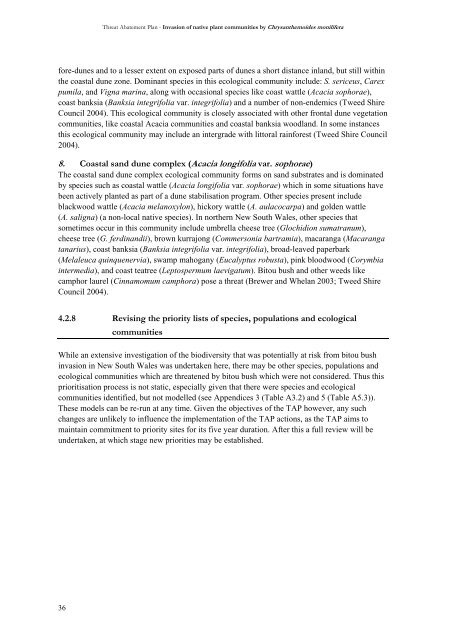NSW Bitou Bush Threat Abatement Plan - Department of ...
NSW Bitou Bush Threat Abatement Plan - Department of ...
NSW Bitou Bush Threat Abatement Plan - Department of ...
Create successful ePaper yourself
Turn your PDF publications into a flip-book with our unique Google optimized e-Paper software.
36<br />
<strong>Threat</strong> <strong>Abatement</strong> <strong>Plan</strong> - Invasion <strong>of</strong> native plant communities by Chrysanthemoides monilifera<br />
fore-dunes and to a lesser extent on exposed parts <strong>of</strong> dunes a short distance inland, but still within<br />
the coastal dune zone. Dominant species in this ecological community include: S. sericeus, Carex<br />
pumila, and Vigna marina, along with occasional species like coast wattle (Acacia sophorae),<br />
coast banksia (Banksia integrifolia var. integrifolia) and a number <strong>of</strong> non-endemics (Tweed Shire<br />
Council 2004). This ecological community is closely associated with other frontal dune vegetation<br />
communities, like coastal Acacia communities and coastal banksia woodland. In some instances<br />
this ecological community may include an intergrade with littoral rainforest (Tweed Shire Council<br />
2004).<br />
8. Coastal sand dune complex (Acacia longifolia var. sophorae)<br />
The coastal sand dune complex ecological community forms on sand substrates and is dominated<br />
by species such as coastal wattle (Acacia longifolia var. sophorae) which in some situations have<br />
been actively planted as part <strong>of</strong> a dune stabilisation program. Other species present include<br />
blackwood wattle (Acacia melanoxylon), hickory wattle (A. aulacocarpa) and golden wattle<br />
(A. saligna) (a non-local native species). In northern New South Wales, other species that<br />
sometimes occur in this community include umbrella cheese tree (Glochidion sumatranum),<br />
cheese tree (G. ferdinandii), brown kurrajong (Commersonia bartramia), macaranga (Macaranga<br />
tanarius), coast banksia (Banksia integrifolia var. integrifolia), broad-leaved paperbark<br />
(Melaleuca quinquenervia), swamp mahogany (Eucalyptus robusta), pink bloodwood (Corymbia<br />
intermedia), and coast teatree (Leptospermum laevigatum). <strong>Bitou</strong> bush and other weeds like<br />
camphor laurel (Cinnamomum camphora) pose a threat (Brewer and Whelan 2003; Tweed Shire<br />
Council 2004).<br />
4.2.8 Revising the priority lists <strong>of</strong> species, populations and ecological<br />
communities<br />
While an extensive investigation <strong>of</strong> the biodiversity that was potentially at risk from bitou bush<br />
invasion in New South Wales was undertaken here, there may be other species, populations and<br />
ecological communities which are threatened by bitou bush which were not considered. Thus this<br />
prioritisation process is not static, especially given that there were species and ecological<br />
communities identified, but not modelled (see Appendices 3 (Table A3.2) and 5 (Table A5.3)).<br />
These models can be re-run at any time. Given the objectives <strong>of</strong> the TAP however, any such<br />
changes are unlikely to influence the implementation <strong>of</strong> the TAP actions, as the TAP aims to<br />
maintain commitment to priority sites for its five year duration. After this a full review will be<br />
undertaken, at which stage new priorities may be established.
















